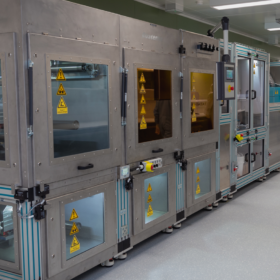Turkish startup developing perovskite-organic tandem solar cell tech
Spacelis is developing lightweight, rollable space-grade perovskite-organic tandem solar PV technology targeting space and terrestrial portable energy applications.
U.S. startup unveils ‘world’s largest’ transparent organic PV window
Next Energy said its 101.6 cm x 152.4 cm laminated transparent power-generating windows were produced with its pilot production line.
Swedish startup offers n-type conductive inks for organic, perovskite solar cells
N-ink, a spinoff of the Linköping University, has developed conductive inks that can be used in the charge extracting layer of organic solar cells and in transport layers of perovskite solar cells.
Coatema launches roll-to-roll production lines for organic, perovskite, dye-sensitized solar cells
German PV equipment company Coatema Coating Machinery says its roll-to-roll processing solutions cover from lab or pilot to production scale.
Danish print finishing equipment provider offers turnkey pilot lines for perovskite, organic solar cells
Denmark-based Grafisk Maskinfabrik (GM) is now selling roll-to-roll turnkey pilot production lines featuring slot-die coating, available through its GM Functionals unit.
New cleaning tool for perovskite, organic PV roll-to-roll production equipment
A German research team has developed a precise cleaning process for electrode deburring in perovskite and organic solar PV roll-to-roll production lines. It is based on commercially available equipment from Germany-based Acp Systems.
Swiss startup offers organic PV-powered asset tracker
Truvami has launched an organic PV-powered asset tracker equipped with localization and sensor technology for battery-free use indoors and outdoors, targeting logistics and manufacturing applications.
Dracula Technologies relaunches production of organic photovoltaic modules in France
The Valence plant can produce 150 million square centimeters of active surface area of OPV modules using its inkjet printing technology, with the aim of quadrupling its capacity by 2026. Sensitive to natural and artificial light, Dracula’s modules operate indoors from any light source and are intended for use in IoT, industrial electronics and as battery replacements.
New electrically conductive adhesives for flexible perovskite, organic solar cells
Panacol, a German adhesive supplier, has launched Elecolit 3648, a one-component electrically conductive adhesive (ECA) for flexible perovskite and organic PV connections. It was conceived to adhere well to a range of materials, including several types of plastic.
Recovering silver from PV waste via green graphene
Researchers at James Cook University have developed a process to synthesize graphene from tangerine peel oil, which they then used to recover silver from waste PV material. To demonstrate the quality of the recovered silver and the synthesized graphene, they made a dopamine sensor that reportedly outperformed reference devices.










